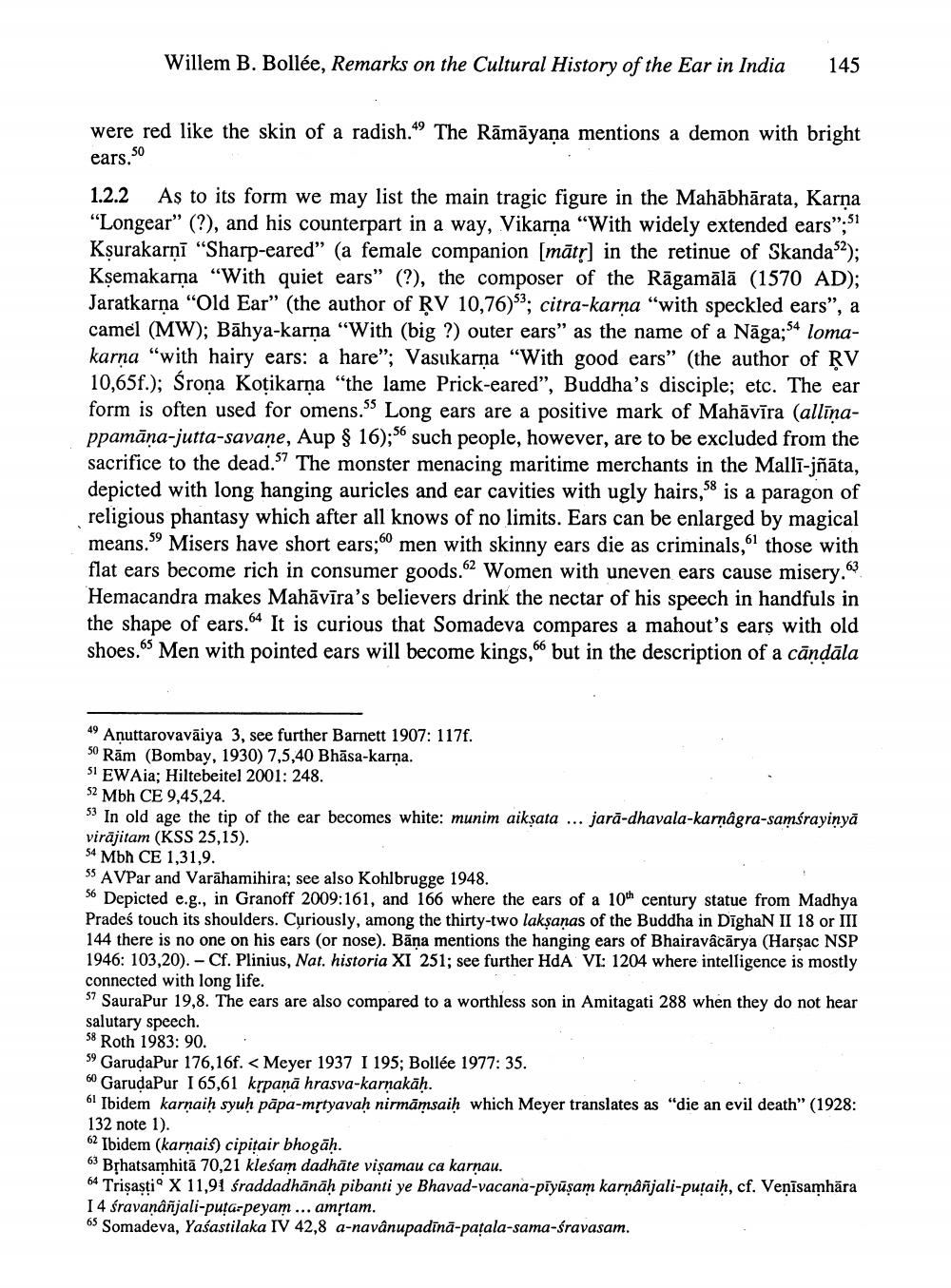________________
Willem B. Bollée, Remarks on the Cultural History of the Ear in India
145
were red like the skin of a radish.49 The Rāmāyana mentions a demon with bright
ears.50
1.2.2 As to its form we may list the main tragic figure in the Mahābhārata, Karna “Longear" (?), and his counterpart in a way, Vikarņa "With widely extended ears”;51 Kșurakarni “Sharp-eared” (a female companion [māt] in the retinue of Skandas2); Ksemakarna “With quiet ears" (?), the composer of the Rāgamālā (1570 AD); Jaratkarna "Old Ear" (the author of RV 10,76), citra-karna "with speckled ears", a camel (MW); Bāhya-karna "With (big ?) outer ears” as the name of a Nāga;54 lomakarna "with hairy ears: a hare"; Vasukarna "With good ears” (the author of RV 10,65f.); Śrona Kotikarna "the lame Prick-eared”, Buddha's disciple; etc. The ear form is often used for omens. Long ears are a positive mark of Mahāvīra (allīnappamāna-jutta-savaņe, Aup & 16);56 such people, however, are to be excluded from the sacrifice to the dead." The monster menacing maritime merchants in the Mallī-jñāta, depicted with long hanging auricles and ear cavities with ugly hairs, 58 is a paragon of religious phantasy which after all knows of no limits. Ears can be enlarged by magical means. Misers have short ears;60 men with skinny ears die as criminals, those with flat ears become rich in consumer goods.62 Women with uneven ears cause misery.63 Hemacandra makes Mahāvīra's believers drink the nectar of his speech in handfuls in the shape of ears.64 It is curious that Somadeva compares a mahout's ears with old shoes. Men with pointed ears will become kings, but in the description of a cāndāla
49 Anuttarovavāiya 3, see further Barnett 1907: 117f. 50 Rām (Bombay, 1930) 7,5,40 Bhāsa-karna. SI EWAia; Hiltebeitel 2001: 248. 52 Mbh CE 9,45,24. 53 In old age the tip of the ear becomes white: munim aikșata ... jarā-dhavala-karnågra-samśrayinyā virăjitam (KSS 25,15). 54 Mbh CE 1,31,9. 55 AVPar and Varāhamihira; see also Kohlbrugge 1948. 56 Depicted e.g., in Granoff 2009:161, and 166 where the ears of a 10th century statue from Madhya Pradeś touch its shoulders. Curiously, among the thirty-two lakṣaṇas of the Buddha in DīghaN II 18 or III 144 there is no one on his ears (or nose). Bāņa mentions the hanging ears of Bhairavâcārya (Harsac NSP 1946: 103,20). -Cf. Plinius, Nat. historia XI 251; see further HDA VI: 1204 where intelligence is mostly connected with long life. 57 SauraPur 19,8. The ears are also compared to a worthless son in Amitagati 288 when they do not hear salutary speech. 58 Roth 1983: 90. 59 GarudaPur 176,16f. < Meyer 1937 I 195; Bollée 1977: 35. 60 GarudaPur 165,61 krpaņā hrasva-karņakāḥ. 61 Ibidem karņaih syuh papa-mrtyavaḥ nirmāmsaih which Meyer translates as "die an evil death" (1928: 132 note 1). 62 Ibidem (karnais) cipitair bhogāh. 6 Brhatsaphita 70,21 klesam dadhāte visamau ca karnau. 64 Trișastio X 11,91 śraddadhānāh pibanti ye Bhavad-vacana-pīyāşam karņâñjali-putaiḥ, cf. Venisamhāra I 4 śravanâñjali-puta-peyam ... amstam. 65 Somadeva, Yaśastilaka IV 42,8 a-navânupadinā-patala-sama-śravasam.




